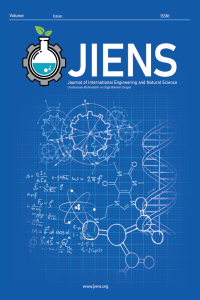Preparation and compatibilization effect of β-cyclodextrin end-functionalized polystyrene for immiscible PCL/PS blends
Preparation and compatibilization effect of β-cyclodextrin end-functionalized polystyrene for immiscible PCL/PS blends
Compatibilization, Solution casting, CuAAC Inclusion complexation,
___
- Rameshwaram J, Yang Y-S, Jeon H (2005) Structure–property relationships of nanocomposite-like polymer blends with ultrahigh viscosity ratios. Polymer 46 (15):5569-5579. https://doi.org/10.1016/j.polymer.2005.05.033
- Ajitha A, Thomas S (2020) Compatibilization of polymer blends, Compatibilization of Polymer Blends, Elsevier, 640.
- Holsti‐Miettinen R, Seppälä J, Ikkala O (1992) Effects of compatibilizers on the properties of polyamide/polypropylene blends. Polymer Eng Sci 32(13):868-877. https://doi.org/10.1002/pen.760321306
- DeLeo C L, Velankar S S (2008) Morphology and rheology of compatibilized polymer blends: Diblock compatibilizers vs crosslinked reactive compatibilizers. Journal of Rheology 52(6):1385-1404. https://doi.org/10.1122/1.2995857
- Koning C, Van Duin M, Pagnoulle C, Jerome R (1998) Strategies for compatibilization of polymer blends. Progress in Polymer Science 23(4):707-757. https://doi.org/10.1016/S0079-6700(97)00054-3
- Patrício T, Bártolo P (2013) Thermal stability of PCL/PLA blends produced by physical blending process. Procedia Engineering 59:292-297. https://doi.org/10.1016/j.proeng.2013.05.124
- Wang H, Dong W, Li Y (2015) Compatibilization of immiscible polymer blends using in situ formed janus nanomicelles by reactive blending. ACS Macro Letters 4(12):1398-1403. https://doi.org/10.1021/acsmacrolett.5b00763
- Lokensgard E (2016) Industrial plastics: theory and applications: Cengage Learning.
- Zhang Y, Huang Y, Mai K (2005) Crystallization and dynamic mechanical properties of polypropylene/polystyrene blends modified with maleic anhydride and styrene. Journal of Applied Polymer Science 96(6):2038-2045. https://doi.org/10.1002/app.21658
- Lv Q, Wu D, Xie H, Peng S, Chen Y, Xu C (2016) Crystallization of poly (ε-caprolactone) in its immiscible blend with polylactide: insight into the role of annealing histories. RSC Advances 6(44):37721-37730. https://doi.org/10.1039/C6RA07752H
- Na Y-H, He Y, Shuai X, Kikkawa Y, Doi Y, Inoue Y (2002) Compatibilization effect of poly (ε-caprolactone)-b-poly (ethylene glycol) block copolymers and phase morphology analysis in immiscible poly (lactide)/poly (ε-caprolactone) blends. Biomacromolecules 3(6):1179-1186. https://doi.org/10.1021/bm020050r
- Chun Y, Kyung Y, Jung H, Kim W (2000) Thermal and rheological properties of poly (ϵ-caprolactone) and polystyrene blends. Polymer 41(24):8729-8733. https://doi.org/10.1016/S0032-3861(00)00263-9
- Shabana H, Olley R, Bassett D, Jungnickel B-J (2000) Phase separation induced by crystallization in blends of polycaprolactone and polystyrene: an investigation by etching and electron microscopy. Polymer 41(14):5513-5523. https://doi.org/10.1016/S0032-3861(99)00713-2
- Ma M, He Z, Yang J, Wang Q, Chen F, Wang K, Zhang Q, Deng H, Fu Q (2011) Vertical phase separation and liquid-liquid dewetting of thin PS/PCL blend films during spin coating. Langmuir 27(3):1056-1063. https://doi.org/10.1021/la104003p
- Ma M, He Z, Li Y, Chen F, Wang K, Zhang Q, Deng H, Fu Q (2012) Surface phase separation, dewetting feature size, and crystal morphology in thin films of polystyrene/poly (ε-caprolactone) blend. Journal of Colloid Interface Science 387(1):262-269. https://doi.org/10.1016/j.jcis.2012.07.087
- Silva L I, Montoya Rojo U M, Riccardi C C (2017) Phase separation and segregation morphology of PCL/PS blends: Quantitative effect of the crystallization temperature, composition, and molecular weight of PS. Polymer Engineering Science 57(10):1062-1072. https://doi.org/10.1002/pen.24480
- Ho R-M, Chiang Y-W, Lin C-C, Bai S (2002) Block copolymer self-assembly ınduced compatibilization of PCL/PS− PEP blends. Macromolecules 35(4):1299-1306. https://doi.org/10.1021/ma011381j
- Harada A, Takashima Y, Yamaguchi H (2009) Cyclodextrin-based supramolecular polymers. Chemical Society Reviews 38(4):875-882. https://doi.org/10.1039/B705458K
- Poulson B G, Alsulami Q A, Sharfalddin A, El Agammy E F, Mouffouk F, Emwas A-H, Jaremko L, Jaremko M (2022) Cyclodextrins: structural, chemical, and physical properties, and applications. Polysaccharides 3(1):1-31. https://doi.org/10.3390/polysaccharides3010001
- Cakir Yigit N, Hızal G, Tunca U (2022) Synthesis of multiarm star block copolymer based on host-guest inclusion complexation. Journal of Innovative Engineering and Natural Science 2(1):1-16. https://doi.org/10.29228/JIENS.54191
- Okumura H, Kawaguchi Y, Harada A (2001) Preparation and characterization of inclusion complexes of poly (dimethylsiloxane)s with cyclodextrins. Macromolecules 34(18):6338-6343. https://doi.org/10.1021/ma010516i
- Kawaguchi Y, Nishiyama T, Okada M, Kamachi M, Harada A (2000) Complex formation of poly (ε-caprolactone) with cyclodextrins. Macromolecules 33(12):4472-4477. https://doi.org/10.1021/ma992103b
- Busche B J, Tonelli A E, Balik C M (2010) Morphology of polystyrene/poly (dimethyl siloxane) blends compatibilized with star polymers containing a γ–cyclodextrin core and polystyrene arms. Polymer 51(6):1465-1471. https://doi.org/10.1016/j.polymer.2010.01.019
- Balik C, Tonelli A, Libert R (2012) Compatibilization of polymer blends with star polymers containing a gamma-cyclodextrin core and polystyrene arms. APS March Meeting Abstracts 2012:Q48. 005.
- Sharma D, Dhingra S, Banerjee A, Saha S, Bhattacharyya J, Satapathy B K (2022) Designing suture-proof cell-attachable copolymer-mediated and curcumin-β-cyclodextrin inclusion complex loaded aliphatic polyester-based electrospun antibacterial constructs. International Journal of Biological Macromolecules 216:397-413.
- Busche B J, Tonelli A E, Balik C M (2010) Compatibilization of polystyrene/poly (dimethyl siloxane) solutions with star polymers containing a γ-cyclodextrin core and polystyrene arms. Polymer 51(2):454-462. https://doi.org/10.1016/j.polymer.2009.11.069
- Cakir N, Hizal G, Becer C R (2015) Supramolecular glycopolymers with thermo-responsive self-assembly and lectin binding. Polymer Chemistry 6(37):6623-6631. https://doi.org/10.1039/C5PY00939A
- Durmaz H, Dag A, Erdogan E, Demirel A L, Hizal G, Tunca U (2010) Multiarm star block and multiarm star mixed‐block copolymers via azide‐alkyne click reaction. Journal of Polymer Science Part A: Polymer Chemistry 48(1):99-108. https://doi.org/10.1002/pola.23765
- Başlangıç: 2021
- Yayıncı: İdris Karagöz
Nesibe YEŞİLDAĞ, Ömer Faruk ÜNSAL, Ramazan GÖMEÇ, Ayşe BEDELOĞLU
Converting polyolefin fibres into CO2 adsorbent by radiation induced grafting
Noor Ashikin MOHAMAD, Nur Afifah ZUBAIR, Mohamed Mahmoud NASEF, Teo Ming TING
Hakan ÖZTÜRKMEN, Yusuf USTA, Serkan TOROS, Fahrettin ÖZTÜRK
Eksik tahrikli döner ters sarkaç sisteminin geribeslemeli doğrusallaştırma tabanlı kademeli kontrolü
PVDF nanofibers composite containing core-shell (ZnO@ZIF-8) for use in smart textile applications
Miladi ATIGHI, Moein JALALI, Mahdi HASANZADEH, Seyed Mansour BIDOKI
Development of reactive digital printing process for cellulosic fabrics
Halil İbrahim TURGUT, Aslı BALÇAK GİRGİN, Özlem YARAR
Andinet Kumella ETİCHA, Yasin AKGÜL, Ayben PAKOLPAKÇİL, Oğuz Kağan ÜNLÜ, Harun ÇUĞ, Ali KILIÇ
Investigation of effect of chestnut sawdust on mechanical properties of epoxy matrix composites
